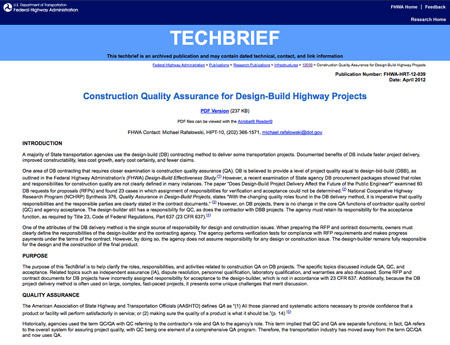U.S. Department of Transportation
Federal Highway Administration
1200 New Jersey Avenue, SE
Washington, DC 20590
202-366-4000
Focus
| Accelerating Infrastructure Innovations |
Publication Number: FHWA-HRT-12-016
Date: August 2012
Printable Version (.pdf, 0.3 mb)
A majority of State transportation agencies are now using the design-build (DB) contracting method for at least some of their new projects, realizing benefits such as faster project completion, improved constructability, reduced costs, and fewer claims following project completion.
DB is an accelerated project delivery method in which the design and construction phases of a project are combined into one contract. This allows aspects of design and construction to take place at the same time and encourages innovation. The Federal Highway Administration (FHWA) selected DB to be one of the methods promoted by its Every Day Counts (EDC) initiative in 2010. For more information on EDC tools and resources available for implementing DB, visit www.fhwa.dot.gov/everydaycounts/projects/methods/db/dbresource.cfm.
Quality assurance (QA) plays a vital role in completing a successful DB project. As FHWA highlights in its new Tech Brief, Construction Quality Assurance for Design-Build Highway Projects (Pub. No. FHWA-HRT-12-039), defining roles, responsibilities, and necessary activities for QA is key to achieving effective quality management for a DB initiative.
The Tech Brief examines six core elements of a construction QA program:
FHWA's Transportation Construction Quality Assurance Reference Manual defines quality control (QC) as "the system used by a contractor party to monitor, assess, and adjust their production or placement processes to ensure that the final product will meet the specified level of quality." Construction Quality Assurance for Design-Build Highway Projects looks at various aspects of QC systems, including the use of test data to determine project acceptance, organizational structure, documentation and records, and the use of consultants to perform QC.
As noted in the Tech Brief, "it is good practice to require the design-builder to provide a comprehensive quality management plan that outlines the overall quality system for both design and construction of the project."
The project acceptance process is also examined, including agency responsibilities; verification sampling and testing; validation of QC data; quality measures for acceptance, including statistical quality measures such as percent-within-limits and the acceptable quality level for work items; and inspection. Just as with traditional design-bid-build projects, the Tech Brief notes, "visual inspection is a key part of agency acceptance on DB projects."
Independent assurance (IA) is another key element in the acceptance process. An IA system is intended to confirm that the sampling and testing activities performed by the agency and design-builder are conducted by qualified personnel using proper procedures and properly calibrated and functioning equipment. The responsibility for IA lies with the transportation agency.
The Tech Brief offers guidance on dispute resolution, qualifications for personnel performing sampling and testing for QC, and qualifications for laboratories used to perform verification testing, QC testing that is included in the acceptance decision, and testing used for IA or dispute resolution. Another important topic covered is the need for DB contracts to describe the process for documentation and disposition of nonconforming work that does not meet the specified level of quality.
Transportation agencies can also find guidance on warranty provisions for DB contracts. The inspection procedure for determining warranty compliance should be clearly outlined and include provisions for notification, so that a representative of the design-builder can observe warranty inspections. A process for disputing warranty inspection findings should also be established.
To download the Tech Brief, visit www.fhwa.dot.gov/publications/research/infrastructure/12039/index.cfm. Printed copies are available by contacting the FHWA Product Distribution Center at 814-239-1160 (email: report.center@dot.gov). For more information on DB project delivery, contact Jerry Yakowenko at FHWA, 202-366-1562 (email: gerald.yakowenko@dot.gov), or visit www.fhwa.dot.gov/everydaycounts. To learn more about the FHWA Materials Quality Assurance Program, contact Michael Rafalowski at FHWA, 202-366-1571 (email: michael.rafalowski@dot.gov), or Dennis Dvorak at the FHWA Resource Center, 708-283-3542 (email: dennis.dvorak@dot.gov).
